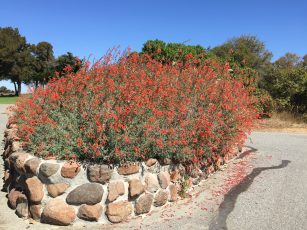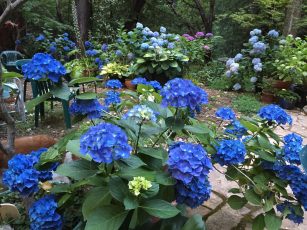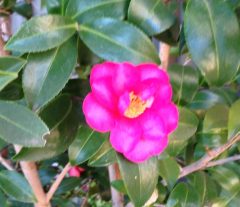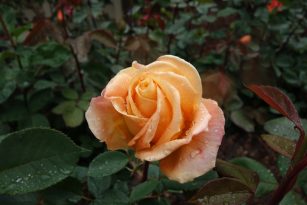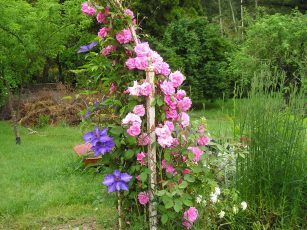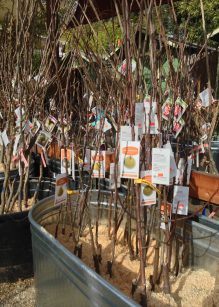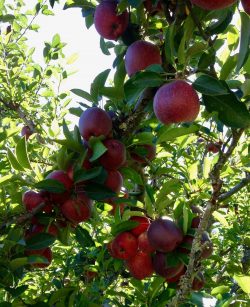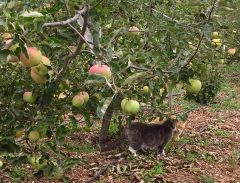It was brought to my attention by a reader who suffers from pollen allergies that blooming acacias are not the cause of allergic reactions at this time of year. Acacias are largely pollinated by insects and their heavy pollen doesn’t tend to become airborne. It’s the non-showy, quiet ones you have to watch out for.
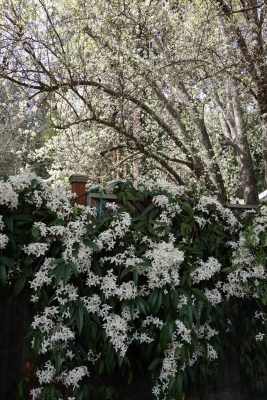
About 25-30 popular landscape plants are responsible for the majority of plant-related allergies in California. During the height of the pollen season- from late February to June- there are often thousands of pollen grains in every cubic meter of air. One can breathe hundreds of them with every breath. Though pollen can travel many miles, the majority tend to stay in the general area of their origin.
Redwoods, oaks, alders, ashes and other wind pollinated trees like olives, birch, box elder, cypress, elm, juniper, maple, fruitless mulberry, pine, walnut, willow and privet are the major source of spring pollen. Most native plants are good in the sneeze-less landscape but if you have bad allergies or asthma it best to avoid wind-pollinated ceanothus, elderberry and coffeeberry.
You may not be able to avoid those culprits growing on other’s property but you can get the most out of your own backyard by creating a sneeze-less landscape. Replacing existing plants may be impractical but planning future plantings with these things in mind will save you a lot of headaches down the road and let you enjoy the sunshine outside in your garden.
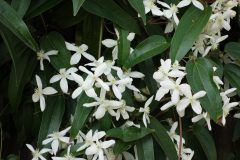
Flower type is a good way to judge plants. The best looking flowers usually cause allergy sufferers the fewest problems. Plants with bright, showy flowers are usually pollinated by insects, rather than by the wind. These flowers produce less pollen and their pollen is larger and heavier, sticking to the insect rather than becoming airborne and lead to sneezing, a runny nose and watery eyes.
Some trees that are good for anti-allergy gardens are apple, cherry, dogwood, magnolia, pear and plum. Shrubs like azaleas, boxwood, lilac, rose-of-Sharon, hydrangea and viburnum are also not likely to cause problems. Good flower choices include alyssum, begonia, clematis, columbine, bulbs like crocus, daffodil, hyacinth. Also dahlia, daisy, geranium, hosta, impatiens, iris, lily, pansy, petunia, phlox, roses, salvia, snapdrag
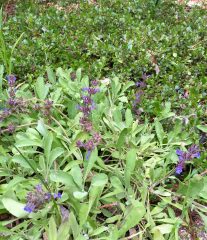
on, sunflower, verbena and zinnia. Lawns of perennial rye grass, blue grass and tall fescue blends are usually OK as they will not flower unless allowed to grow to 12″ or higher. Bermuda grass, on the other hand, can pollinate when the lawn is very short, sometimes as quickly as a few days after mowing.
Hopefully, our rainy weather will not cause problems for allergy sufferers. Symptoms may become worse if the body reacts to the disappearance of the pollen following its initial appearance only to have to have more of it later in the spring. According to Dr. Stanley Fineman, an allergist with the Atlanta Allergy and Asthma Clinic, “You become sensitized to it, so when you’re…re-exposed, you can get an even more violent allergic reaction.”
Here’s to a sneezeless spring for you allergy sufferers.


